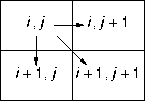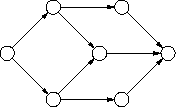The sum of a chain is the sum of the matrix entries through which the chain passes.
The problem is to find a chain of maximal sum. Show this problem can be solved using dynamic programming, and develop a dynamic-programming algorithm to solve the problem.
Given a chain of maximal sum, divide the chain at any one of the elements M[i, j] through which it passes. The chain from M[0, 0] to M[i, j] must also have maximal sum, otherwise it could be replaced with a chain from M[0, 0] to M[i, j] having a larger sum, contradicting the assertion that the whole chain had a maximal sum. A similar argument shows that the chain from M[i, j] to M[m - also has maximal sum. The optimal-subproblem property holds.
A recursive solution to this problem follows immediately from the problem statement:
Because we're interested in asymptotic behavior, we ignore the boundary conditions. T(n) = 3T(n - 1) is an approximate recurrence relation forint max-chain(x, y) return M[x, y] + max(max-chain(x - 1, y), max-chain(x, y - 1), max-chain(x - 1, y - 1))
max-chain(), where n is the length of the chain; this relation
unrolls into an O(n3) and max-chain() has exponential
run-time. However, there are only O(mn) maximum sum paths, so the
repeated-subproblem property holds.
Let C be an m by n matrix with C[i, j] equal to the
maximal sum of the chain from M[0, 0] to M[i, j]. The dynamic programming
solution to the maximal sum chain is
int max-chain(M)
C[0, 0] <- M[0, 0]
for i <- 1 to m - 1
C[0, i] <- C[0, i - 1] + M[0, i]
for i <- 1 to n - 1
C[i, 0] <- C[i - 1, 0] + [Mi, 0]
for i <- 1 to m - 1
for j <- 1 to n - 1
C[i, j] <- M[i, j] + max(C[i - 1, j],
C[i, j - 1],
C[i - 1, j - 1])
return C[m - 1, n - 1]
max-chain() writes every element of C exactly once, so it's an
O(mn) algorithm.
The problem is to derive an algorithm that finds the minimum cost path from the source to the sink. Show this problem can be solved using dynamic programming, and derive a dynamic programming algorithm that solves the problem.
This problem is solved in essentially the same way as was the previous problem; the major difference between the two problems is the way you advance from one subproblem to the next.
Given a path of minimal cost, divide the path at any one of the nodes n in the path. The subpath from the source to n must also have minimal cost, otherwise it could be replaced with a path from the source to n having a smaller cost, contradicting the assertion that the path had minimal cost. A similar argument shows that the path from n to the sink also has minimal cost. The optimal-subproblem property holds.
A recursive solution min-path(n), which finds a minimum cost path from the
source to node n follows immediately from the problem statement:
int min-path(n)
m <- infinity
for each (v, n) in E
m <- min(m, min-path(v) + w(v, n))
return w
min-path() is T(n) = |E|T(n - 1), where n is the length of
the path. This relation unrolls into an O(|E|n) expression and
min-path() has exponential run-time. However, there are only 0(n)
minimal paths in the graph, so the repeated-subproblem property holds.
Let C be an |V|-element vector with C[n] equal to the
minimal cost of the path from the source to node n. The dynamic
programming solution to the minimal-cost path is
int min-path(G)
C <- [0, infinity, ..., infinity]
for x in G.V
for (u, v) in G.E
if C[v] > C[u] + w(u, v)
C[v] <- C[u] + w(u, v)
return C[sink]
min-path() isn't the most asymptotically efficient algorithm for
finding the shortest path; see Section 25.4 of the text for details.
Given an minimal solution S1, ... Sn, order them by increasing maximal element and divide the sets into two parts. The left part must use a minimum of sets to cover the points within the left part; if it didn't, the points could be covered by a smaller number of sets, contradicting the claim that the entire set cover is minimal. A similar argument holds for the right part. The optimal-subproblem property holds.
The key to a greedy algorithm for the set cover problem is to sort the point set in increasing order (in this case; decreasing order would work too):
min-set-cover(S)
S <- sort(S)
covers <- [{}, {}, ..., {}]
c <- 0
first <- S[0]
for i <- 0 to |S| - 1
if S[i] - first > 1.0
c++
first <- S[i]
covers[c] <- union(covers[c], { S[i] })
return covers
covers is an array of sets covering the input set S.
min-set-cover() keeps stuffing points in S into a set in covers
until the next point from S is more than 1 away from the smallest element
in the current cover set in covers. In that case, min-set-cover()
moves on to the next empty cover set in covers, remembers the next point
from S as the new smallest element, and continues.
To show min-set-cover() is correct, we need to show the greedy-choice
property holds. Let S1, ..., Sn be an arbitrary minimal cover
for the point set S ordered in increasing order by minimum point. Let
s1 be the smallest point in S and let s2 be the largest
point in S that is no more than 1.0 away from s2; that is, the
greedy algorithm puts points s1 through s2 into its first cover
set.
s1 is in S1; if any of the other greedy points in s1 through s2 are not in S1, they can be moved into S1. Note that the set from which the point moved must contain other points not in S1, otherwise the covering S1, ... Sn would not be minimal.
S1 cannot contain any other points then those in s1 through s2 because all other points are more than 1.0 away from s1. By possibly shifting points among the sets Si, it is possible to make S1 equal to the first greedy cover set without changing the number of cover sets. We can now throw away S1 and the points s1 through s2 and repeat the argument. In this way, it's possible to transform any minimal solution to the cover set problem for S into the greedy solution, and the greedy-choice property holds.
You all should recognize this problem; it's just Huffman's encoding without the encoding part. A binary tree storing the words to minimize comparisons during look up will put the more frequently accessed words nearer the root; more precisely, the binary tree should minimize
sum(i = 1 to n, d(wi)f(i))The
opt-bst() algorithm creates such a tree:
opt-bst(W, f)
Q <- init(W, f)
for i <- 1 to |W| - 1
x <- extract-min(Q)
y <- extract-min(Q)
insert(Q, node(x, y, x.f + y.f))
return extract-min(Q)
The proof of the optimal-subproblem property is also as it was for Huffman's algorithm: starting with a greedy optimal tree and create a modified tree by compressing two leaf nodes into a combined leaf node. The resulting tree is also optimal.
You can find the details on either of these proofs in Section 17.3 of the text.

